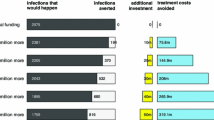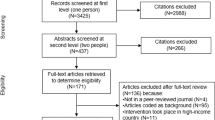Abstract
This study assessed the costs and effectiveness of an HIV prevention program based on the distribution of anti-AIDS kits and a needle exchange service which has been in operation in Navarra, Spain, since 1993. Total costs of the program, including production, storage, distribution, and management, were estimated. Effectiveness, defined as the number of averted HIV infections among injection drug users due exclusively to needle use patterns was calculated as a function of the level of coverage of the program using a mathematical model. The estimated number of averted HIV infections ranged from 7.59 (in 1995) to 1.23 (in 2000). Yearly incremental cost-effectiveness ratios (ICER) ranged from € 8,331 (in 1994) to € 44,287 (in 2000) per HIV infection averted. With the health care costs of treating an HIV infection estimated at € 99,371, the program has been cost-saving every year throughout the period considered. One-way sensitivity analysis was performed for five uncertain parameters. The results confirmed our findings. We conclude that this program was cost-saving from the health care system perspective.


Similar content being viewed by others
References
Bonnet F, Morlat P, Chene G, Mercie P, Neau D, Chossat I, Decoin M, Djossou F, Beylot J, Dabis F, Groupe d'Epidemiologie Clinique du SIDA en Aquitaine (2002) Causes of death among HIV-infected patients in the era of highly active antiretroviral therapy, Bordeaux, France, 1998–1999. HIV Med 3:195–199
Bouhnik AD, Moatti JP, Vlahov D, Gallais H, Dellamonica P, Obadia Y (2002) Highly active anti-retroviral treatment does not increase sexual risk behaviour among French HIV infected injection drug users. J Epidemiol Community Health 56:349–353
Brinkman K, Smeitink JA, Romijn JA, Reiss P (1999) Mitochondrial toxicity induced by nucleoside-analogue reserve-transcriptase inhibitors is a key factor in the pathogenesis of antiretroviral-therapy-related lipodystrophy. Lancet 354:1112–1125
Cabasés JM, Sánchez E (2001) Economía y sida: evaluación económica de programas sanitarios. In: Bueno F, Najera R (eds) Salud Pública y Sida. Doyma Madrid Cap 30:291–299
Cohen MH, French AL, Benning L, Kovacs A, Anastos K, Young M, Minkoff H, Hessol N (2002) Causes of death among women with human immunodeficiency virus infection in the era of combination antiretroviral therapy. Am J Med 113:91–98
Drummond MF, McGuire A (2001) Economic evaluation in health care. Oxford: Oxford University Press
Drummond MF, O'Brien B, Stoddart G, Torrance GW (1997) Methods for the economic evaluation of health care programmes, 2nd edn. Oxford: Oxford University Press
Garcia-Samaniego J, Soriano V, Miro JM, Romero JD, Brugera M, Castilla J, Esteban JI, Gonzalez J, Lissen E, Moreno A, Moreno S, Moreno-Otero R, Ortega E, Quereda C, Rodriguez M, Sanchez-Tapias JM (2002) Management of chronic viral hepatitis in HIV-infected patients: Spanish Consensus Conference. HIV Clin Trials 3:99–114
Gibson DR, Flynn NM, Perales D (2001) Effectiveness of syringe exchange programs in reducing HIV risk behavior and HIV seroconversion among injection drug user. AIDS 15:1329–1341
Gobierno de Navarra, Departamento de Salud (2002) ¿Cómo estamos de salud 2000? Pamplona
Gold MR, Siegel JE, Russel LB, Weinstein MC (eds) (1996) Cost-effectiveness in health and medicine. Oxford: Oxford University Press
Gold M, Gafni A, Nelligan P, Millson P (1997) Needle exchange programs: an economic evaluation of a local experience. Can Med Assoc J 157:255–262
Heimer R, Khoshnood K, Bigg D, Guydish J, Junge B (1998) Syringe use and re-use: effects of syringe exchange programs in four cities. J Acquir Immune Defic Syndr Hum Retrovirol 18 [Suppl 1]:S37–S44
Hellinger FJ (1993) The lifetime cost of treating a person with HIV. JAMA 270:474–478
Holtgrave DR, Pinkerton SD, Jones TS, Lurie P, Vlahov D (1998) Cost and cost-effectiveness of increasing access to sterile syringe and needles as an HIV prevention intervention in the United States. J Acquir Immune Defic Syndr Hum Retrovirol Hum Retrovirol 18 [Suppl 1]:S133–S138
Jacobs P, Clader P, Taylor M, Houston S, Saunders LD, Albert T (1999) Cost effectiveness of Streetworks' needle exchange program of Edmonton. Can J Public Health 90:168–171
Kaplan EH (1994) A method for evaluating needle exchange programmes. Stat Med 13:2179–2187
Kaplan EH, Heimer R (1994) A circulation theory of needle exchange. AIDS 8:567–574
Kaplan EH, Heimer R (1994) HIV incidence among needle exchange participants: estimates from syringe tracking and testing data. J Acquir Immune Defic Syndr 7:182–189
Kaplan EH, Heimer R (1995) HIV incidence among New Haven needle exchange participants: update estimates from syringe tracking and testing data. J Acquir Immune Defic Syndr 10:175–176
Kaplan EH, Khoshnood K, Heimer R (1994) A decline in HIV-infected needles returned to New Haven's needle exchange program: client shift or needle exchange? Am J Public Health 84:1991–1994
Laufer FN (2001) Cost-effectiveness of syringe exchange as an HIV prevention strategy. J Acquir Immune Defic Syndr Hum Retrovirol 28:273–278
Lurie P, Drucker E (1997) An opportunity lost: HIV infections associated with lack of a national needle-exchange programme in the USA. Lancet 349:604–608
Lurie P, Gorsky R, Jones TS, Shomphe L (1998) An economic analysis of needle exchange and pharmacy-based programs to increase sterile syringe availability for injection drug user. J Acquir Immune Defic Syndr Hum Retrovirol 18 [Suppl 1]:S126–S132
Manfredi R (2002) HIV disease and advanced age: an increasing therapeutic challenge. Drugs Aging 19:647–669
Ministerio de Sanidad y Consumo (2001) Boletín epidemiológico semanal. Instituto de Salud Carlos III 9:181–192
Moatti JP, Vlahov D, Feroni I, Perrin V, Obadia Y (2001) Multiple access to sterile syringes for injection drug users: vending machines, needle exchange programs and legal pharmacy sales in Marseille, France. Eur Addict Res 7:40–45
Moreno C, Sola J, Urtiaga M, Martinez V, Fernandez C, Sáinz de Murieta J, Dorronsoro I (2002) Epidemiological surveillance of HIV/AIDS in Navarra. Anales del sistema sanitario de Navarra 25:197–204
Perlman DC, Gourevivitch MN, Trinh C, Salomon N, Horn L, Des Jarlais DC (2001) Cost-effectiveness of tuberculosis screening and observed preventive therapy for active drugs injectors at a syringe-exchange program. J Urban Health 78:550–567
Pinkerton S, Abramson P (1998) The Bernoulli-process model of HIV transmission. In: Holtgrave D (ed) Handbook of economic evaluation of HIV prevention programs. New York: Plenum, pp 13–32
Pinkerton SD, Holtgrave DR, DiFranceisco WJ, Stevenson L, Kelly JA (1998) Cost-effectiveness of a community-level HIV risk reduction intervention. Am J Public Health 88:1239–1242
Prins M, Sabin CA, Lee CA, Devereux H, Coutinho RA (2000) Pre-AIDS mortality and its association with HIV disease progression in haemophilic men, injecting drug users and homosexual men. AIDS 18:1829–1837
Sachs L (1998) Estadística aplicada. Labor, Barcelona, pp 38:187
Schrappe M, Lauterbach K (1998) Systematic review on the cost-effectiveness of public health interventions for HIV prevention in industrialized countries. AIDS 12 [Suppl A]:S231–S238
Steffen T, Blättler R, Gutzwiler F, Zwahlen M (2001) HIV and hepatitis virus infections among injection drug users in medically controlled heroin prescription programme. Eur J Public Health 11:425–430
Urtiaga M, Ardanaz E, Martinez M (1991) Aproximación a la prevalencia de usuarios de opiáceos en Navarra en 1990. V Master internacional de atención sanitaria al medio ambiente. Pamplona
Acknowledgements
This study was financed by an unrestricted grant from Fundación para la investigación y la prevención del SIDA en España, no. 2078/99. The authors are grateful for the comments made on earlier version of the paper presented to the XIV International AIDS Congress, Barcelona, July 2002, and for the comments and suggestions made by two anonymous referees.
Author information
Authors and Affiliations
Corresponding author
Rights and permissions
About this article
Cite this article
Cabasés, J.M., Sánchez, E. Costs and effectiveness of a syringe distribution and needle exchange program for HIV prevention in a regional setting. HEPAC 4, 203–208 (2003). https://doi.org/10.1007/s10198-003-0172-7
Published:
Issue Date:
DOI: https://doi.org/10.1007/s10198-003-0172-7




